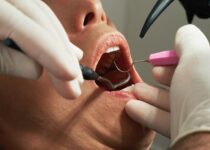Dental Cysts – Solutions, Mechanisms, Treatments
Dental cysts
From the Greek “ Kustis ”, which means “bladder”, the cyst is a pathological cavity which contains a liquid, semi-liquid, even airy content. It should be noted that it is never created by the accumulation of pus as one can sometimes hear it.
What is a dental cyst?
The cyst is a tumor since it corresponds well to an increase in volume of a clearly delimited tissue without specifying the cause. This tissue formation takes place as a result of a benign cell growth disturbance. The cyst is a benign tumor insofar as it is not serious, and cannot give rise to metastases. This does not mean that it is not pathological, however.
Dental cysts are very common and extremely diverse. They develop in place, where they originated.
Possible causes of a dental cyst
Cysts may arise from debris from osteogenesis, the process by which bone tissue develops. These remains, isolated for a considerable time, would lead, under the effect of a stimulation of still unknown origin, the formation of a cyst.
According to some authors, the sudden proliferation of this debris is secondary to inflammation of dental or periodontal origin, and gives rise to inflammatory cysts .
It is also known that the formation and development of a cyst depends both on cell proliferation, on the accumulation of fluid in its lumen and on bone resorption. These 3 parameters are then variable depending on the type of cyst we are dealing with 1 .
Symptoms of dental cyst
The orofacial sphere is particularly complex from a histological point of view. This peculiarity makes possible the great variety of cysts . Some will have a relationship with the dental organ, these are the odontogenic cysts, others not, the non-odontogenic cysts.
However, their diversity does not lead to a multitude of different symptoms. In the vast majority of cases, bone swelling is the first warning sign 2 . Inspection allows you to notice the consistency of the swelling, while other factors, such as age, frequency, location of the tumor and certain radiological signs, may guide the diagnosis.
Dental signs, on the other hand, are nonexistent for a long time. When these warning signs appear, it means that the lesion has already reached a large volume:
– Toothache, even brief
– Dental mobility
– A fistula
– A feeling of pressure
– Spontaneous fractures
– Occlusion disorders
– Dental trips.
The x-ray is the basic exam for screening, although the risk of errors exist in view of the possible range of damage. The orthopantomogram can appreciate its extension.
The different cysts
Developmental odontogenic epithelial cysts:
These cysts which derive from the odontogenic epithelium can appear during the development of a tooth or after its eruption.
We note in particular the gingival cyst of the newborn, the gingival cyst of the adult (uncommon), the odontogenic keratocyst, the dentigerous cyst (formed within the organ of the enamel of a tooth still included), eruptive cyst (which surrounds the crown of a tooth ready to erupt), lateral periodontal cyst, calcifying odontogenic cyst and odontogenic glandular cyst.
Non-odontogenic epithelial cysts
These non-odontogenic cysts represent only 5% of maxillary cysts. There is the nasopalatin cyst 3 (the most frequent of the group and detected thanks to the mobility of the incisors that it involves), the nasolabial cyst and the globulomaxillary cyst.
Inflammatory odontogenic cysts
These cysts are most often linked to infectious complications of untreated or insufficiently treated dental pulp infections. As they are often asymptomatic, these cysts are discovered during routine examination. They can nevertheless appear during acute and particularly painful episodes linked to the constitution of a hard swelling.
There are the lateral radicular cyst, the apical cyst, the residual cyst (2 to 10% of dental cysts) and the paradental cyst.
Treatment of dental cysts
Despite their diversity, dental cysts have one thing in common: their treatment. When the cyst causes superinfection or is the cause of functional or unsightly repercussions, it is enucleated by surgery. Surgical treatment under general anesthesia may also be possible depending on the condition of the lesion. In most cases, and unlike dental fistula, the lesion does not go away on its own when the infectious focus supposedly at the origin of its appearance is treated.
You may also like:Canker sores – Causes, Symptoms and Treatments


